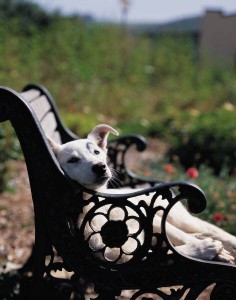Plants Safe For Dogs
Spring is finally here, which means we can put away our winter gear and spend more time outdoors enjoying the long, warm days that lie ahead. This is also the time when many people start planting their outdoor gardens, but there’s one thing that many pet owners may overlook – whether or not those colorful flowers and beautiful blooms are actually safe for dogs. Many plants can actually be toxic to dogs, and your garden may be filled with all sorts of temptations for your dog to sniff, dig and chew. So with a little planning and preparation, you can create a beautiful outdoor garden using flowers and plants that are safe for dogs. Maybe you’re designing a large garden filled with a variety of flowers and shade trees where you can have a sitting area, or perhaps you want to design a smaller space for freshly grown herbs and tasty organic fruits and vegetables. So here are some tips to help you create a pet-friendly garden that both you and your four-legged friend will enjoy.
Plan Ahead
Before you start planting your “dog friendly” garden, think about what type of plants you want to grow. Plan your garden by drawing a basic diagram of what you’d like your garden to look like – there are quite a few on-line tools you can use to help you plan and draw your new garden.
On your diagram, decide which flowers and plants would work best in the sunny and shady areas of your yard, what plants are best suited for your region and climate, and what kind of soil conditions you have. As you design and plant your garden, you’ll want to leave plenty of space between the plants, especially for plants that tend to grow tall or wide. Once you have your garden mapped out, go outside and stake out the areas in your garden that you’ll be working on.
Selecting Your Plants
Many garden stores or plant nurseries can provide a list of plants that are toxic to dogs and both the ASPCA and Humane Society of the United States have a complete list of plants that are poisonous as well as vegetables and plants safe for dogs. Y. You might want to print this list and keep it with you when you go the nursery to help you select your plants for your garden. Choosing non-toxic plants for your garden is one of the most important things you can do to create a safe pet-friendly garden. If you have a question about whether a certain plant is toxic or safe for dogs, it’s always best to consult with your veterinarian.
According to the ASPCA website, you can add lots of color and variety to your garden with full sun, partial sun and even full shade plants. Here are a few suggestions of flowering plants safe for dogs:
Zinnia (Zinnia species)
Garden Marigold (Calendula officinalis)
Petunia (Petunia species)
Snapdragons (Antirrhinum majus)
Nasturtium (Tropaeolum majus)
African Violet (Saintpaulia spp.)
If you think you’d like to create a fruit and vegetable garden, here are just a few suggestions of vegetable plants safe for dogs.
Acorn Squash (Cucurbita pepo)
Beets (Beta vulgaris) – Additional Common Names: Beet Root, Red Beet, Swiss Chard, Roman Kale, Sugar Beet
Cucumber (Cucumis sativa)
Strawberries (Fragaria)
Zucchini Squash (Cucurbia pepo cv zucchini)
Remember, it’s important to do your research in advance when choosing the plants that you will be using in your garden. There are actually quite a few common plants and flowers that can be unsafe or even fatal to dogs. Some popular plants to avoid include Oleander, Sago Palm, Calla Lilies, Azalea, and Rhododendron, among others. Also, be careful with flowers and plants that have sharp thorns such as roses or cacti as they can injure your dog’s paws or nose.
Walkways And Play Areas
If you decide you want to add some paths and walkways in your garden, you can use smooth rocks and small pebbles to create a walkway that your dog can walk on comfortably. You can also make some smooth, sandy paths lined with driftwood on the sides for borders. You might also want to add a special play area just for your dog, especially if your dog likes to dig. You can easily section off a space in your yard for your dog and make a soft, sandy play area with plenty of shade and fresh drinking water where he can run around and have fun without hurting himself or your garden. You might even want to add a small wading pool for him to play in, which he surely will enjoy during the hot summer months! You can also put some of his favorite toys in this play area so he understands that this is a special spot just for him.
Pesticides And Fertilizers
Be careful with pesticides – pesticides that are used to control weeds and insects in your garden can be extremely hazardous to your dog. It’s best to avoid using pesticides completely, but if you have to use them, make sure you follow the directions and keep them stored safely away from your dog. The most dangerous forms of pesticides include snail bait with metaldehyde. These baits are highly toxic and ingestion requires immediate veterinary attention. Other pesticides that are toxic to dogs include fly bait with methomyl and most forms of gopher or rat bait (zinc phosphide).
Fertilizers can also be harmful to your dog if ingested; it can also get on their pads which can be caustic (or ingested if they lick their paws). Most fertilizers contain iron, copper, zinc, cobalt, boron, manganese and/or molybdenum which can be toxic if consumed in large amounts. Also, fertilizers may contain herbicides, pesticides and fungicides which are also toxic to dogs. If you think your dog was exposed to fertilizer, contact your veterinarian or Animal Poison Control Center (888) 426-4435 immediately. Also stay away from cocoa mulch. While it smells wonderful with that rich, sweet chocolaty scent, it can also pose health problems for your dog.
So while we’re all excited that spring is finally here and we can now go outside and do a little gardening, in the long run it’ll be worth the extra time to plan and create a safe outdoor environment that we can enjoy with our dogs. Do you have a pet-friendly gardening tip you’d like to share? We’d love to hear from you!
(orig 3/2015; updated 3/2016)







Leave a Reply